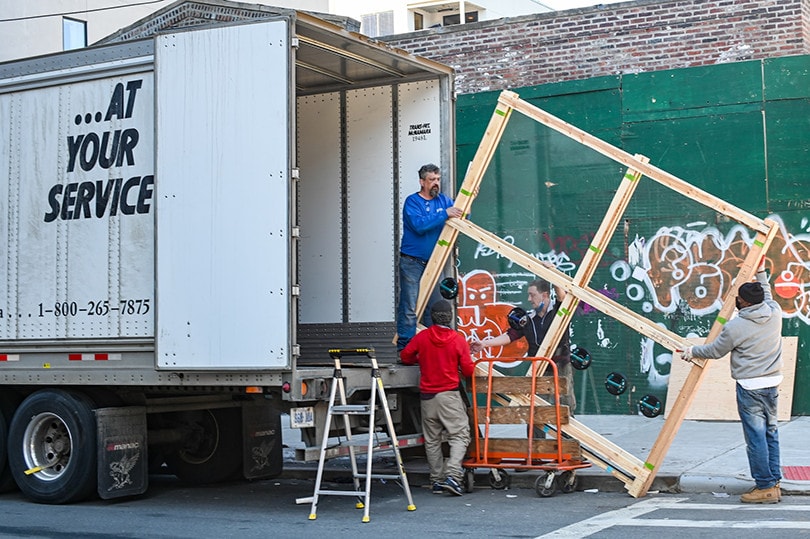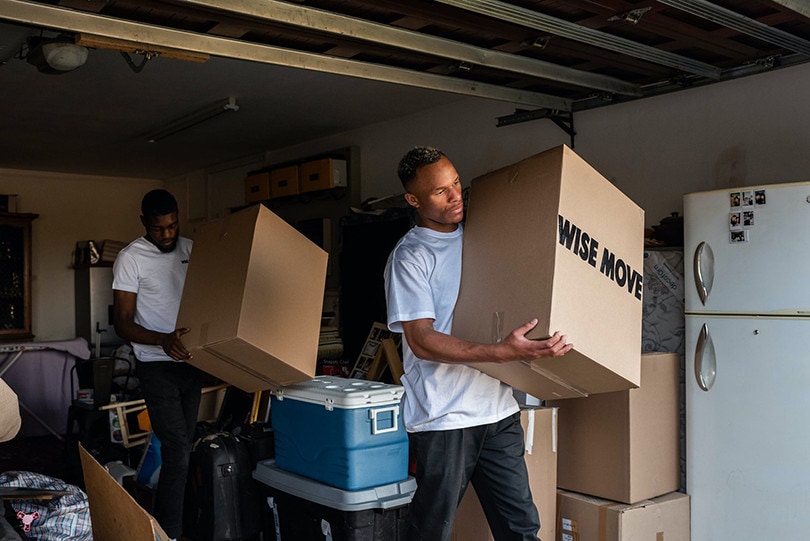12 Moving Industry Statistics & Facts: 2025 Update
-
Pete Ortiz
- Last updated:

Nobody enjoys the moving process, but that doesn’t stop close to 10% of the population from uprooting themselves annually. The average person moves over 10 times in their lifetime. It sounds like a high number, but when you look at past decades, you’ll see we’re moving less than ever!
The moving industry changes as much as any other. There will always be a need for people to relocate, yet the reasons behind the moves, the economics of moving, and the hottest destinations are constantly shifting. It’s an intriguing evolution to follow, so to keep you up to speed on the current state, here are 12 moving statistics and facts you should know this year.
Click below to jump ahead:
 The 12 Moving Industry Statistics
The 12 Moving Industry Statistics
- The moving and storage industry supports over 186,000 jobs across the country.
- Summer is the peak moving season.
- Roughly 3.5% of movers have on-the-job injuries every year.
- The BBB receives 13,000 complaints about movers every year.
- Only 40.8% of Americans had a final moving cost that matched the initial estimate.
- Americans lose over $2 million each year from moving scams.
- Nearly 1 in 5 people stated they made a move because of COVID.
- The number of moves in 2020 was the lowest in a single year in U.S. Census history.
- More than one-third of Americans have moved for a job.
- About 80% of people who moved stayed in the same state.
- New Jersey has the highest net loss of residents each year.
- Arkansas has the highest net gains in residents.

The Moving Profession
1. The moving and storage industry supports 186,382 jobs across the country.

American Trucking Associations
Most people think of trucking when they think of transport, and with the pandemic-induced employment shortages, people understand and feel its impact in measurable ways these days. But the moving industry is no slouch in contributing to the economy. Across 16,522 businesses in the United States, 186,382 employees in the moving and storage sector contribute to $32.2 billion in economic impact.
According to the American Moving & Storage Association, most moving companies are small operations, with 47.8% of businesses managing fewer than five employees. The largest companies, consisting of over 100 employees, only account for 8.7% of the industry.
2. Summer is the peak moving season.
Moving Labor
It should be no surprise that the summer months are the preferred time to move. Kids are out of school, making district changes much easier, and the weather is as accommodating as possible. As a result, 80% of moves occur from April–September. Meanwhile, only 5% of movers do so in the last two months of the year.
With more summer moving comes a higher demand for limited services, so expect to pay more if you want to make the change during the peak season. Companies may charge up to 30% more, and cancellations are more likely as they become loaded up with requests.
3. The average professional mover is over 40 years old.

Zippia
Moving furniture and appliances can be back-breaking work, so you’d expect it to be more of a young man’s game. Surprisingly, 50% of movers are over 40 years old, while only 27% are 20–30 years old. But age doesn’t necessarily equal experience. Turnover is relatively high in the industry, with 67% of movers staying with their company for only two years or less.
 The Moving Experience
The Moving Experience
4. The BBB receives 13,000 complaints about movers every year.
Better Business Bureau
The moving industry is rife with shifty business behavior. While most companies are legitimate, the nature of the industry leaves many consumers vulnerable as soon as they entrust their property to a mover.
The problem is prevalent enough for the Better Business Bureau to receive over 13,000 complaints and negative reviews every year. Due to unresolved complaints, over 1,300 moving companies have an “F” rating with the BBB. That’s slightly over 8% of the 16,522 organizations in business.
The stats are eye-opening enough, but they become even more incredible when you consider that by the BBB’s estimates, less than 10% of victims file reports. The issue has become so dire that industry leaders created MoveRescue, an organization that supports victims of moving scams.
5. Only 40.8% of Americans had a final moving cost that matched the initial estimate.

Move.org
The number one complaint the BBB receives involves overcharging. In 2019, higher-than-quoted prices accounted for roughly 57% of all complaints. And the issue likely isn’t contained to a few bad actors. According to Move.org, less than 41% of people who moved in 2020 paid the initial quoted cost.
Individuals often fail to estimate the initial moving cost accurately, and quotes will fall through due to unexpected situations during the job. Many experts recommend getting a binding estimate to prevent unexpectedly high moving costs after the process starts. The FMCSA offers free resources to help customers understand their rights so they can better protect themselves from scams.
6. Americans lose over $2 million each year from moving scams.
Hire a Helper
The BBB estimates that, since 2015, Americans have lost close to $19 million to moving scams. Although only $1.9 million in losses were reported in that period, the BBB includes unreported scam estimates, bringing the total to roughly $2 million each year.
Scams appeared to spike during the pandemic years of 2020–2021. Since the first year of reporting in 2015, reported scams stayed under 50 until 2018. That year had 112 reported scams, while the following year saw even more at 121 filed incidents.
The pandemic could be an outlier rather than the start of a new trend, as 2022 scam rates look more similar to those of pre-pandemic years. Unique circumstances likely caused the aggressive spike. According to experts, more time online possibly made more consumers fall victim to scams, and the various mental and emotional side effects of the pandemic lockdown also likely contributed to poor decision-making.
 Why People Move
Why People Move
7. Nearly 1 in 5 people stated they made a move because of COVID.

Hire a Helper
Scams weren’t the only way that the pandemic changed the moving industry. A Hire a Helper survey found that, for several reasons, COVID caused 21% of all moves in 2021.
On the positive side, the work-from-home explosion stemming from the pandemic allowed many people to detach themselves from a job’s physical location and move based on their comfort. Of those who cited a COVID-related move, 37% did so because of the remote work opportunity.
Unfortunately, another 22% of individuals who moved during the pandemic did so because of financial hardships. Layoffs and shifty landlord practices were common themes of the peak pandemic years, forcing many into sudden, unexpected adjustments.
8. The number of moves in 2020 was the lowest in a single year in U.S. Census history.
U.S. Census Bureau
Given the upheaval in the job market and housing practices, 2020 sounds like it should have been a banner year for the moving industry. With 8.4% of the population moving that year, it was actually the slowest in U.S. Census history!
Oddly enough, unlike many other moving stats, 2020’s decline in moving rates isn’t unique to the pandemic years. Moving rates have been dropping for decades. From 1947 to 1969, the number of Americans on the move never dipped below 19% for any given year. But rates began falling steadily in the ’70s. After shooting back up to 20.2% in 1984, the numbers again began declining gradually and have been ever since.
9. More than one-third of Americans have moved for a job.
Porch
From educational opportunities to marriage to homeownership and retirement, there are several reasons for the nearly 12 moves a person makes through the years. Unsurprisingly, one-third of respondents in a Porch survey revealed that they had moved at one point for a job.
Most moves for jobs were for new positions, with technology, finance and insurance, and education being the top industries for relocation. Only one out of every five moves for work was for an existing job.
Where People Are Moving
10. About 80% of people who move stay in the same state.
U.S. Census Bureau
Despite the changing motivations for moves and the general downward trend of annual migrations, one statistic that doesn’t seem to deviate much from history is interstate moving. Most movers stay within state lines. Since the Census began putting it on record, the percentage of people staying in the same state has hovered between 80–85% of all movers.
11. New Jersey has the highest net loss of residents each year.

United Van Lines
New Jersey’s high cost of living and taxes make it one of the most popular places to flee when opportunity hits. It consistently has some of the highest net losses each year alongside states like California, New York, and Illinois.
Retirement, jobs, and general relief from high prices are common motivations for leaving New Jersey and other states defined by big cities. As more Baby Boomers enter retirement and remote work opportunities expand, there are more reasons than ever for residents to make the move.
12. Arkansas has the highest net gains in residents.
Hire a Helper
“Out of the big city and into the small town” seems to be the trend for many modern movers. In their exodus from New Jersey, New York, and California, most people are settling down in places like Arkansas, Vermont, South Carolina, and Florida.
Although Florida is a popular retirement destination known for urban stretches like Orlando and Miami, more rural regions are the preferred landing spot for many movers. According to United Van Lines, most retiring Gen Xers and Baby Boomers are settling down in less dense areas like Punta Gorda, Sarasota, and Cape Coral.
 Frequently Asked Questions
Frequently Asked Questions
How Expensive Is It to Move?
At $9,060, the average full-service move isn’t cheap. Moving, in general, has increased in price due to rising operating costs and increasing demand that companies are struggling to manage due to COVID.
Variables such as the state you move from, the timing of your move, and traveling distance have a substantial impact on your final moving costs. In nearly every circumstance, you will save significantly by doing the move yourself, as the average price of a moving van rental is only $1,128. (Move.org)
How Old Are Most People Who Move?
Gen Zers and Millennials are far more likely to move than older generations. Of the 24 and under crowd, over 13% moved in 2020–2021. In the 25–64 age range, that number drops to 8.9%, and once you get to people over 65 years old, the number of movers dwindles to a mere 2.6%. (U.S. Census Bureau)
Why Aren’t People Moving As Much Anymore?
Many people had to throw their moving plans out the window because of the pandemic. With remote work, COVID also presented new opportunities for other people aching to make a move. In reality, the pandemic may influence motivations, but it likely has little to do with the final numbers. Moving has been becoming less and less common for decades.
Several factors are at play in the slowdown, including an aging Baby Boomer population that is more likely to stay in place and the fading yet still present effects of the Great Recession. Relocations are no longer the highly incentivized opportunities for employees they once were, and the general state of job availability is too shaky for many to justify a move. (NY Times)
 Conclusion
Conclusion
The decline in geographic mobility can be challenging to grasp, especially considering how millennials approach home ownership and life changes. They’re less likely to buy a home, get married, or have a child at a young age than generations past, yet they’re leading the trend of staying in place.
Mobility trends can be fascinating due to their dynamic and often counterintuitive nature. The past few decades have put Americans in uniquely demanding economic and social circumstances, from housing crashes and recessions to global pandemics. The moving industry has subsequently seen some of the most significant upheavals. It will be interesting to see how it shifts in a post-pandemic landscape.
Featured Image Credit: Robinson Greig, Unsplash
Contents

 The 12 Moving Industry Statistics
The 12 Moving Industry Statistics The Moving Experience
The Moving Experience Frequently Asked Questions
Frequently Asked Questions